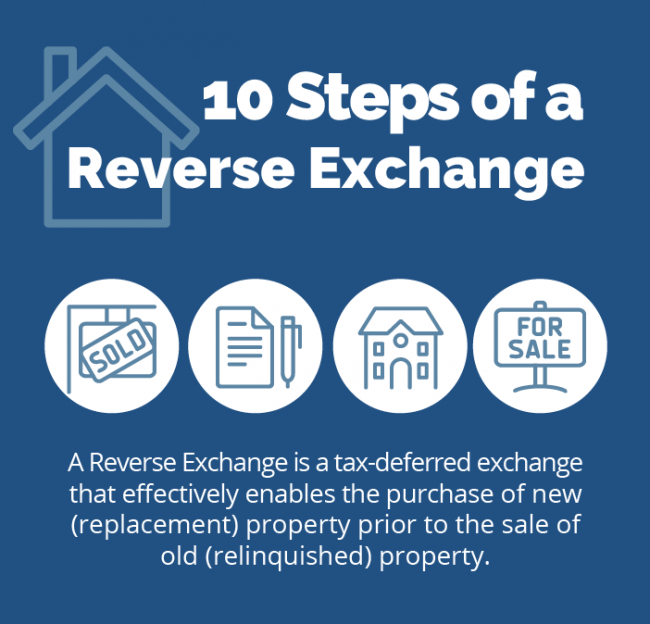BLOG
10 Steps of a Reverse Exchange

View the entire 10 Steps of a Reverse Exchange Infographic.
Accruit, LLC is a national provider of 1031 Exchange Qualified Intermediary (QI) and Also referred to as an "EAT", is typically a special purpose, limited-liability company that is used to own the legal title to property that is being parked as part of a reverse exchange. An exchange accommodation titleholder may not be a disqualified person. Exchange Accommodation Titleholder (EAT) services for simple and complex exchanges. Accruit handles all types of real property like-kind exchanges. Specialized EAT services are provided by Accruit Exchange Accommodation Services LLC.
A reverse exchange is a tax-deferred exchange that enables the purchase of new (replacement) property prior to the sale of the old (relinquished) property.
Step One

The taxpayer enters into a contract to purchase the replacement property, assuring the contract has no restriction against assigning the contract to a third party. In the unlikely event that it is so restricted, the contract should be negotiated to allow the contract to be assigned to the reverse exchange accommodator, Accruit Exchange Accommodation Services (AEAS) or a special purpose entity (SPE), typically an LLC, owned by AEAS to hold title to the property. Under IRS vernacular, the SPE is known as an Also referred to as an "EAT", is typically a special purpose, limited-liability company that is used to own the legal title to property that is being parked as part of a reverse exchange. An exchange accommodation titleholder may not be a disqualified person. Exchange Accommodation Titleholder (EAT).
Step Two

The taxpayer or their advisor contacts Accruit to start an exchange and obtain a reverse exchange document package. The taxpayer and AEAS, enter into a This is a term that the IRS coined in the “reverse exchange” Rev. Proc. 2000-39 pertaining to the overarching agreement which must be put in place between the Exchange Accommodation Titleholder and the taxpayer. The Rev. Proc. contains certain provisions which are mandatory to be in the agreement in order for these parking arrangements to be in the safe harbor set forth in the Rev. Proc. This applies to reverse exchanges of relinquished or replacement property as well as build-to-suit and property improvement exchanges. Qualified Exchange Accommodation Agreement (QEAA) for replacement property whereby the SPE, as the EAT, will take title on the date of closing to the replacement property. The SPE is set up with AEAS as its sole member.
Step Three

The taxpayer assigns the replacement property purchase contract to the EAT.
Step Four

Unless the taxpayer is providing 100% of the necessary funds, a taxpayer selected lending bank loans the funds required for the purchase to the EAT to enable it to acquire the replacement property. The EAT signs any applicable loan documents as the borrower, however, the taxpayer signs as the guarantor of any such loan. In the event the bank does not make a 100% loan-to-value loan, the taxpayer makes a second loan for the balance needed, which should include any earnest money that may have been previously advanced. The documents required for any taxpayer loan are furnished by Accruit and typically include a Non-Recourse Promissory Note and a Pledge Agreement of Membership A charge paid by a borrower to a lender for the opportunity to borrow funds via a loan or the funds earned by an account owner/beneficiary on the amount held on deposit. Interest to secure the loan.
Step Five

The taxpayer and the EAT enter into a contract for the sale of the replacement property from the SPE to the taxpayer as well as a triple net In the context of reverse exchange administration a Master Lease between the Exchange Accommodation Titleholder as Lessor and the taxpayer as Lessee, is often used in order for taxpayer to be able to sublease the property to the actual property tenants. This removes the need for the Exchange Accommodation Titleholder from having any interaction with the property tenants. If also puts responsibility on the taxpayer to pay for utilities, taxes and insurance. Master Lease , which allows the taxpayer to oversee the day-to-day management of the property while it is held by the EAT. The lease provides that, in lieu of rent, the taxpayer will pay all debt service to the lender and/or the taxpayer, assuming a secondary loan from the taxpayer. Accruit may request that the taxpayer execute an Environmental Indemnity Agreement.
Step Six

Funds are sent directly to the closing by the lender and/or the taxpayer. The closing takes place and the SPE takes title to the property. Evidence of liability insurance must be furnished to Accruit showing the SPE as the insured party, while the lender and the taxpayer may appear as additional insureds.
Step Seven

Within six months (180 days) of the replacement property closing, the taxpayer enters into a contract for the sale of the relinquished property and enters into a standard Tax A 1031 exchange conducted under the safe harbor 1991 Treasury Regulations wherein the replacement property is received up to 180 days after the disposition of the relinquished property. Typically what people mean when referring to a 1031 exchange, Starker exchange, like-kind exchange, delayed exchange, etc. Deferred Exchange Agreement with Accruit, who serves as the QI. The taxpayer assigns its rights (but not its obligations) under the contract for the sale of the relinquished property to the QI and gives to the buyer(s) written notice of this assignment on or before the closing. The closing must take place within the 180-day period and the net proceeds of the sale are paid to the QI.
Step Eight

The taxpayer assigns its rights under the contract for the purchase of the replacement property (which is now being acquired from the EAT) to the QI and gives written notice of this assignment to the EAT, on or before the closing.
Step Nine

The taxpayer directs the QI to disburse the exchange proceeds to the EAT as part, or all, of the purchase price. The EAT receives the funds and immediately wires those funds to the lending bank and/or to the taxpayer to pay down all or part of the debt.
Step Ten

The taxpayer takes ownership of the replacement property via an assignment of the membership interest in the EAT which transfers the LLC, and the property it holds, from the member (AEAS) to the taxpayer. Alternatively, a deed may be issued to the taxpayer by the EAT and the LLC may be dissolved. The taxpayer takes the membership interest or the deed relating to the replacement property subject to the balance of any debt.
Note: The foregoing suggested procedural outline is made available by Accruit to interested parties and to licensed attorneys and it is intended to be used as a guideline. It is not intended to be relied upon, or viewed in any way, as legal advice, and is furnished for purposes of convenience only. As a qualified intermediary, Accruit is prohibited from providing tax or legal advice. (“Exchangor" or "Exchanger") Individual or entity desiring an exchange. Taxpayer s must seek such counsel from their advisors.


